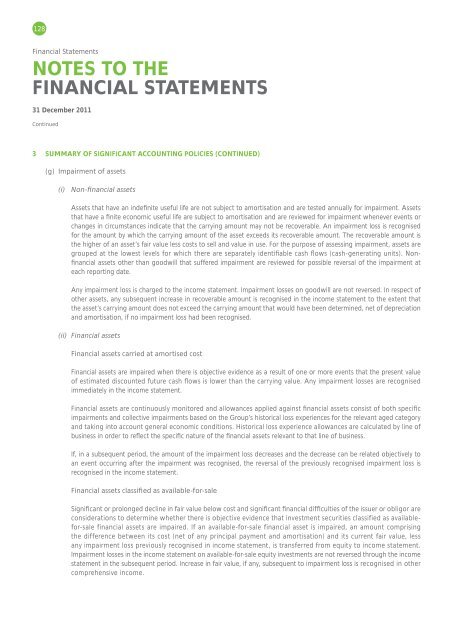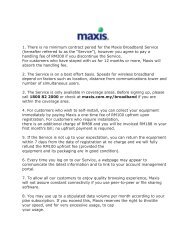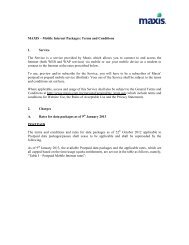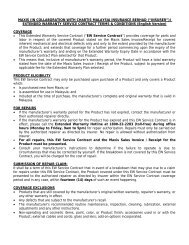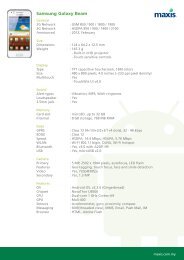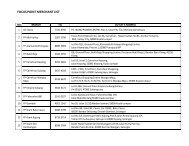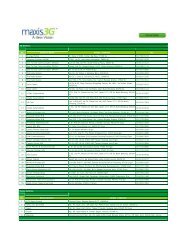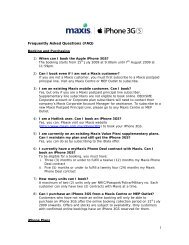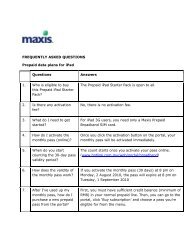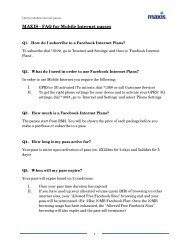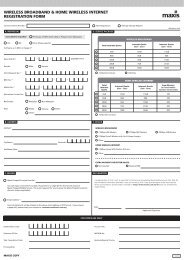ENRICHING LIVES EXPANDING HORIZONS - Maxis
ENRICHING LIVES EXPANDING HORIZONS - Maxis
ENRICHING LIVES EXPANDING HORIZONS - Maxis
You also want an ePaper? Increase the reach of your titles
YUMPU automatically turns print PDFs into web optimized ePapers that Google loves.
128<br />
Financial Statements<br />
NOTES TO THE<br />
FINANCIAL STATEMENTS<br />
31 December 2011<br />
Continued<br />
3 SUMMARY OF SIGNIFICANT ACCOUNTING POLICIES (CONTINUED)<br />
(g) Impairment of assets<br />
(i) Non-financial assets<br />
Assets that have an indefinite useful life are not subject to amortisation and are tested annually for impairment. Assets<br />
that have a finite economic useful life are subject to amortisation and are reviewed for impairment whenever events or<br />
changes in circumstances indicate that the carrying amount may not be recoverable. An impairment loss is recognised<br />
for the amount by which the carrying amount of the asset exceeds its recoverable amount. The recoverable amount is<br />
the higher of an asset’s fair value less costs to sell and value in use. For the purpose of assessing impairment, assets are<br />
grouped at the lowest levels for which there are separately identifiable cash flows (cash-generating units). Nonfinancial<br />
assets other than goodwill that suffered impairment are reviewed for possible reversal of the impairment at<br />
each reporting date.<br />
Any impairment loss is charged to the income statement. Impairment losses on goodwill are not reversed. In respect of<br />
other assets, any subsequent increase in recoverable amount is recognised in the income statement to the extent that<br />
the asset’s carrying amount does not exceed the carrying amount that would have been determined, net of depreciation<br />
and amortisation, if no impairment loss had been recognised.<br />
(ii) Financial assets<br />
Financial assets carried at amortised cost<br />
Financial assets are impaired when there is objective evidence as a result of one or more events that the present value<br />
of estimated discounted future cash flows is lower than the carrying value. Any impairment losses are recognised<br />
immediately in the income statement.<br />
Financial assets are continuously monitored and allowances applied against financial assets consist of both specific<br />
impairments and collective impairments based on the Group’s historical loss experiences for the relevant aged category<br />
and taking into account general economic conditions. Historical loss experience allowances are calculated by line of<br />
business in order to reflect the specific nature of the financial assets relevant to that line of business.<br />
If, in a subsequent period, the amount of the impairment loss decreases and the decrease can be related objectively to<br />
an event occurring after the impairment was recognised, the reversal of the previously recognised impairment loss is<br />
recognised in the income statement.<br />
Financial assets classified as available-for-sale<br />
Significant or prolonged decline in fair value below cost and significant financial difficulties of the issuer or obligor are<br />
considerations to determine whether there is objective evidence that investment securities classified as availablefor-sale<br />
financial assets are impaired. If an available-for-sale financial asset is impaired, an amount comprising<br />
the difference between its cost (net of any principal payment and amortisation) and its current fair value, less<br />
any impairment loss previously recognised in income statement, is transferred from equity to income statement.<br />
Impairment losses in the income statement on available-for-sale equity investments are not reversed through the income<br />
statement in the subsequent period. Increase in fair value, if any, subsequent to impairment loss is recognised in other<br />
comprehensive income.


